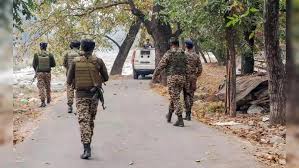Militants have largely limited their area of operation to Jammu over the past year or so, with terrorism dwindling into insignificance in Kashmir. However, two successive terror attacks in the Valley this October suggest that the situation may be changing in J-K. A report by Riyaz Wani

On October 20, just two days after the newly elected NC-Congress government was sworn in, militants struck at the construction site on Srinagar-Ladakh highway, killing seven employees including a doctor. The attack once again hurtled militancy to the centre stage of the political discourse in Jammu and Kashmir. The killings followed the peaceful elections which brought the NC-Congress coalition to power and are thus a source of deep concern for not just the newly elected J&K government but also the centre. The attack was also the biggest in terms of killings after the June 9 shooting on a pilgrims’ bus in Reasi district of Jammu region in which seven pilgrims, the driver, and the conductor died, while 41 others were injured.
In addition to the scale of attack on the Kashmir highway, its target was equally deserving of attention. The construction site belonged to Apco Infratech, a UP-based firm building the 6.5 km Z-Morh tunnel for all-weather connectivity between Gagangir on the side of Ladakh and the tourist hub of Sonamarg in Kashmir. When completed, the tunnel will not just shorten the distance between Kashmir and Ladakh but make the connectivity between the two regions all-weather. This gives the project significant strategic importance. The attack’s real intent thus seems to have been to harm the project. If anything, it shows the militancy is getting more ambitious and choosing to hit the targets that are of strategic value to the country.
The Resistance Front (TRF), has claimed responsibility for the attack. The TRF, banned by the Union Home Ministry in January 2023 under the Unlawful Activities (Prevention) Act, is classified as a terrorist organization for its links to Pakistan-based Lashkar-e-Taiba.
Four days after the tunnel attack on October 24, the militants struck again, this time at the Valley’s prominent tourist hub Gulmarg, killing three soldiers and two porters. In over three decades of the turmoil in the Valley, even when militancy was at its peak in the nineties, it is rare that Gulmarg has witnessed a militancy-related incident. This has created a difficult situation for the government.
Is militancy reviving in Kashmir too after its resurgence in Jammu region. The tunnel and Gagangir attacks seem to point in this direction.
This is not to downplay the gains made on the security front in the valley in recent years. Militancy has by and large shrunk into insignificance in the region. Jammu division, on the other hand, has been in the news this year mainly for security reasons. Militancy in the region has revived after over a decade of absence. Recurrent attacks have brought Jammu to the edge.
It is believed that the militants mounting these attacks – both in Jammu and now also in Kashmir – have infiltrated from across the border, although their exact number is not known. The dense forests of the region have made it difficult for security forces to track them.
The situation is made even more concerning by the fact that the forest area where the militants are hiding extends to Shopian in South Kashmir, the district that until 2020 was a hotbed of militancy. But up until now the militants have largely chosen to stay in Jammu only, possibly because the region has a lower concentration of security forces than the Valley and also a warmer climate throughout the year. Now this seems to be changing as the two successive attacks in the Valley seem to suggest.
“The Gagangir attack shows that the militants now threaten peace in the Valley. This calls for the government to rethink its security strategy,” read an editorial in a local daily. “After the return of militancy in Jammu, the government can ill-afford to let the violence return to the Valley.”












